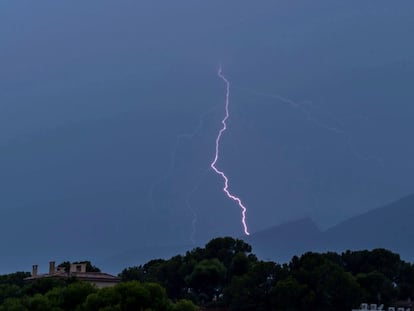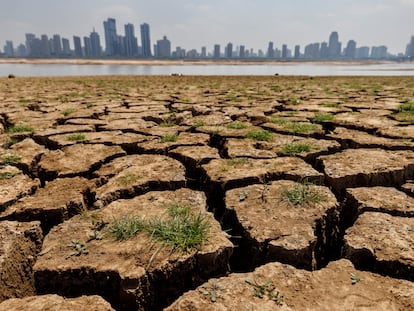Nearly two weeks under fire: Wave of wildfires continues to ravage western Canada
High temperatures and strong winds are making it difficult for firefighters to control the blazes, which are affecting air quality in big urban areas


Western Canada has been battling wildfires for nearly two weeks. Authorities warned that the wave of wildfires is unprecedented for this time of the year, and that the country must be better prepared to face July and August, the hottest months of the year. High temperatures — which have broken several records — and strong winds are making it difficult for firefighters to control the blazes.
In the province of Alberta, there are 91 active fires, with 27 classified as out of control, according to Alberta Wildfire information unit manager Christie Tucker. “Smoky conditions can make it difficult to fly over wildfires, which can mean sometimes it takes longer for us to get an assessment,” she said at a press conference on Wednesday. The province declared a state of emergency on May 7. More than 17,000 people are still under evacuation orders. So far this year, some 534,000 hectares have been devastated by the flames.
A total of 1,600 provincial firefighters are battling the blazes. They have been joined by 600 firefighters from other parts of the country, as well as 300 members of the armed forces. On Monday, Canadian Prime Minister Justin Trudeau visited Edmonton, the capital of Alberta. Soldiers “have been deployed to provide firefighting support, help evacuate isolated communities, and make sure people are safe,” Trudeau tweeted after his visit.
The province of British Columbia has also been affected by the fires. There are currently 58 active blazes, mainly in the north of the province. An open-burning ban will begin in the province on Thursday, while a campfire ban will apply to the Prince George Fire Region. In the province of Saskatchewan, there are 27 active fires. The Shaw fire and Vermette fire are of particular concern due to their size: 47,000 and 45,000 hectares respectively.
The wildfires have affected air quality in areas hundreds of miles away, including some of the large urban centers. Environment Canada issued a warning in Calgary —Alberta’s most populous city — for smoke and toxic particles, as well as reduced visibility. The department also issued air quality warnings in Regina and Saskatoon, in Saskatchewan province, and for northeastern areas of British Columbia.
The forest fires have affected the country’s oil production, which has fallen by about 4%. Alberta — the source of Canada’s main oil reserves — has been hit especially hard. In the summer of 2021, a dizzying rise in temperatures — a phenomenon known as a “heat dome” — triggered a wave of wildfires in western Canada. One of the fires devastated 90% of Lytton, a community in British Columbia. A few days prior to the blaze, it had recorded a temperature of 49.6ºC (121.3ºF), a national record.
Sign up for our weekly newsletter to get more English-language news coverage from EL PAÍS USA Edition
Tu suscripción se está usando en otro dispositivo
¿Quieres añadir otro usuario a tu suscripción?
Si continúas leyendo en este dispositivo, no se podrá leer en el otro.
FlechaTu suscripción se está usando en otro dispositivo y solo puedes acceder a EL PAÍS desde un dispositivo a la vez.
Si quieres compartir tu cuenta, cambia tu suscripción a la modalidad Premium, así podrás añadir otro usuario. Cada uno accederá con su propia cuenta de email, lo que os permitirá personalizar vuestra experiencia en EL PAÍS.
¿Tienes una suscripción de empresa? Accede aquí para contratar más cuentas.
En el caso de no saber quién está usando tu cuenta, te recomendamos cambiar tu contraseña aquí.
Si decides continuar compartiendo tu cuenta, este mensaje se mostrará en tu dispositivo y en el de la otra persona que está usando tu cuenta de forma indefinida, afectando a tu experiencia de lectura. Puedes consultar aquí los términos y condiciones de la suscripción digital.
More information
Archived In
Últimas noticias
Maduro pleads not guilty before the federal court in New York: ‘I am still the president of Venezuela’
A new test can detect Alzheimer’s from a finger prick
UN team enters Sudanese city of El Fasher after paramilitary massacre: ‘It’s like a ghost town’
A recipe for resistance: Indigenous peoples politicize their struggles from the kitchen
Most viewed
- Gilles Lipovetsky: ‘If you want to live better and fall in love, take Prozac, don’t look to philosophy’
- Alain Aspect, Nobel laureate in physics: ‘Einstein was so smart that he would have had to recognize quantum entanglement’
- Alvin Hellerstein, a 92-year-old judge appointed by Bill Clinton, to preside over Maduro’s trial in New York
- Why oil has been at the center of Venezuela-US conflicts for decades
- Maduro’s downfall puts China’s relationship with Venezuela to the test










































